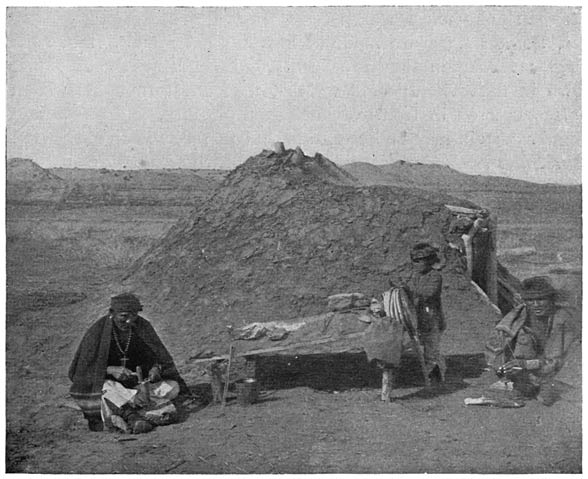The Navajo Hogan: A Resilient Symbol of Culture and Belief
The Navajo people are a Native American tribe with a rich history and culture. Among the most distinctive aspects of their culture is their traditional dwelling, the hogan. With over 300,000 persons claiming Diné heritage, the Navajo people primarily live in the southwestern United States, particularly in the Four Corners region. The hogan is a unique architectural structure that has evolved over time and continues to be a significant symbol in Navajo culture.
Historical Development of the Hogan

The Navajo hogan has its origins in the early dwellings of the Ancestral Puebloan people, who lived in the Four Corners region centuries before the Navajo arrived. The Puebloans built their homes from materials such as stone and adobe, and some of these early designs can be seen in the ruins of Chaco Canyon and Mesa Verde.
When the Navajo arrived in the region, they adopted some of the building techniques and materials used by the Puebloans but adapted them to create their own unique style of architecture. The hogan, as it is known today, has undergone several changes in design throughout history. The earliest known hogans were circular and cone-shaped, with a central hole at the apex for ventilation and smoke from the fire. This style is known as the male hogan, or “forked stick” hogan.
Over time, the design of the hogan evolved, and a new, more rectangular style called the female hogan emerged. This design was better suited for larger families, as it provided more living space and better insulation during cold winters. The female hogan also featured a vestibule, or entranceway, which helped to keep out the elements and provided additional storage space. Despite these changes, the core principles of hogan construction remained the same, with a focus on using local materials and respecting the natural environment.
Construction of a Navajo Hogan
The traditional Navajo hogan is constructed using a combination of natural materials found in the surrounding environment, such as wood, earth, and stone. The building process is labor-intensive and requires a deep understanding of the local environment, as well as skilled craftsmanship.
The framework of the hogan is typically constructed using wooden poles, often Ponderosa pine or Juniper, which are carefully selected and cut to the appropriate size. These poles are then arranged in a circular or hexagonal pattern, with the larger poles forming the main support structure and the smaller poles filling in the gaps.
Once the framework is in place, the next step is to create the walls of the hogan. This is usually done using a combination of mud and stone or adobe bricks, depending on the local resources available. The mud is carefully applied to the wooden framework in layers, allowing each layer to dry before adding the next. This process is repeated until the walls are thick and sturdy, providing excellent insulation against the elements. The exterior of the hogan is often finished with a layer of plaster, which helps to protect the structure and provides a smooth, attractive appearance.
The roof of the hogan is typically made from wooden poles, which are laid across the top of the structure and covered with a layer of earth or other insulating materials. This creates a solid, weather-resistant surface that also helps to regulate the temperature inside the hogan. In the case of the male hogan, the central hole at the apex of the structure serves as both a ventilation system and a smoke hole for the interior fire.
The floor of the hogan is usually made from compacted earth and may be covered with rugs, blankets, or animal hides for added comfort. A central fire pit is often included in the design, providing warmth and light during the cold winter months. The hogan’s entrance generally faces east, toward the rising sun, in accordance with Navajo spiritual beliefs.
Symbolism and Cultural Significance
The hogan is more than just a practical dwelling for the Navajo people; it is also imbued with deep spiritual and cultural significance. The structure itself represents the Navajo worldview, with its circular or hexagonal shape symbolizing the interconnectedness of all things and the four cardinal directions representing the four sacred mountains that surround the Navajo homeland.
The east-facing entrance of the hogan is particularly significant, as it represents the Navajo belief in the importance of the rising sun and its life-giving properties. The hogan is often constructed in accordance with traditional rituals and blessings, which are believed to imbue the structure with positive energy and protection from harm.
In addition to its spiritual significance, the hogan also serves as a gathering place for family and community members. Traditional Navajo ceremonies, such as the Kinaaldá (a coming-of-age ceremony for young girls), often take place within the hogan, and it is a space for storytelling, teaching, and sharing knowledge among generations.
Modern Use and Adaptations
The hogan remains an integral part of Navajo culture and identity, although traditional hogans are no longer used as a primary residence. Instead, they are still being built and utilized for storage and as a place for Navajo women to concentrate on their tasks. Many Navajo families have adopted more modern building materials and methods for their primary residence while incorporating traditional design elements and principles.
These modern hogans often use contemporary building materials, such as concrete, steel, or glass, while still retaining the distinctive circular or hexagonal shape and east-facing entrance. Some Navajo communities have also built larger, communal hogans that serve as cultural centers, schools, or community gathering spaces. These modern hogans reflect Navajo adaptability in modern times while still honoring the importance of traditional practices and beliefs.
Interaction with Other Tribes
Throughout history, the Navajo people have interacted with other tribes and peoples, both through trade and cultural exchange. The development of the hogan was influenced by the earlier architecture of the Ancestral Puebloan people, and the Navajo have also shared their hogan-building techniques and knowledge with neighboring tribes, such as the Apache and Ute.
However, it’s important to note that Navajo culture and traditional practices, including the hogan, have faced numerous challenges over time. The forced assimilation policies of the US government and the impacts of colonialism have threatened the preservation of Navajo culture and language. In recent times, economic, political, and environmental pressures have also made it challenging for Navajo communities to maintain traditional practices and beliefs.
Despite these challenges, the hogan stands as a symbol of Navajo resilience and adaptability. It reflects their ability to learn from and adapt to their environment and the cultures they encountered. This exchange of ideas and techniques not only enriched Navajo culture but also fostered a greater understanding and appreciation among the various tribes and peoples of the region.
Conclusion
In conclusion, the Navajo hogan is a unique and important part of Navajo culture and history. Its design and construction reflect the Navajo worldview and spiritual beliefs, and it serves as a gathering place for community members to share knowledge and celebrate their culture. While modern adaptations have been made to the hogan, it remains a symbol of Navajo resilience and adaptability in the face of cultural change and adversity.
Bibliography
For further reading on the Navajo hogan and its cultural and historical significance, the following sources are recommended:
- Kluckhohn, C., & Leighton, D. (1974). The Navaho. Cambridge, MA: Harvard University Press.
The Navaho by Clyde Kluckhohn and Dorothea Leighton is an authoritative and comprehensive study of the Navajo Indians, offering insights into their history, culture, and the challenges they face today. Lauded for its interdisciplinary approach and sympathetic, unbiased perspective, this book is a valuable resource for those interested in the Navajo people, anthropology, sociology, or race relations. - Locke, R. F. (1992). The Book of the Navajo. Los Angeles, CA: Mankind Publishing.
- Page, S. (1995). Diné: A History of the Navajos. Albuquerque, NM: University of New Mexico Press.
- Roessel, R. A. (1983). Navajo Studies at Navajo Community College. Tsaile, AZ: Navajo Community College Press.
- Thornton, R. “Navajo Hogan Home” (AccessGenealogy, 2010), accessed April 3, 2023, https://accessgenealogy.com/native/navajo-hogan.htm.
Regarding Diné architecture, this article offers a detailed description of the construction and types of traditional Navajo hogans. While Thornton notes the decline in hogan construction during the late 20th century, he fails to address the ongoing cultural significance of these structures for the Diné people. For many Diné, hogans continue to serve as important symbols of their cultural identity, and some still use them for ceremonial purposes or as part of their everyday lives. By exploring the contemporary relevance of hogans, the article would offer a more complete picture of Diné culture and heritage.
These sources provide valuable insight into the construction and symbolism of the Navajo hogan, as well as the broader context of Navajo history, culture, and interactions with other tribes and peoples. By exploring these resources, readers can gain a deeper understanding of the importance of the hogan in Navajo life and the rich tapestry of Native American interconnected histories, cultures, and experiences that shape the region today.
